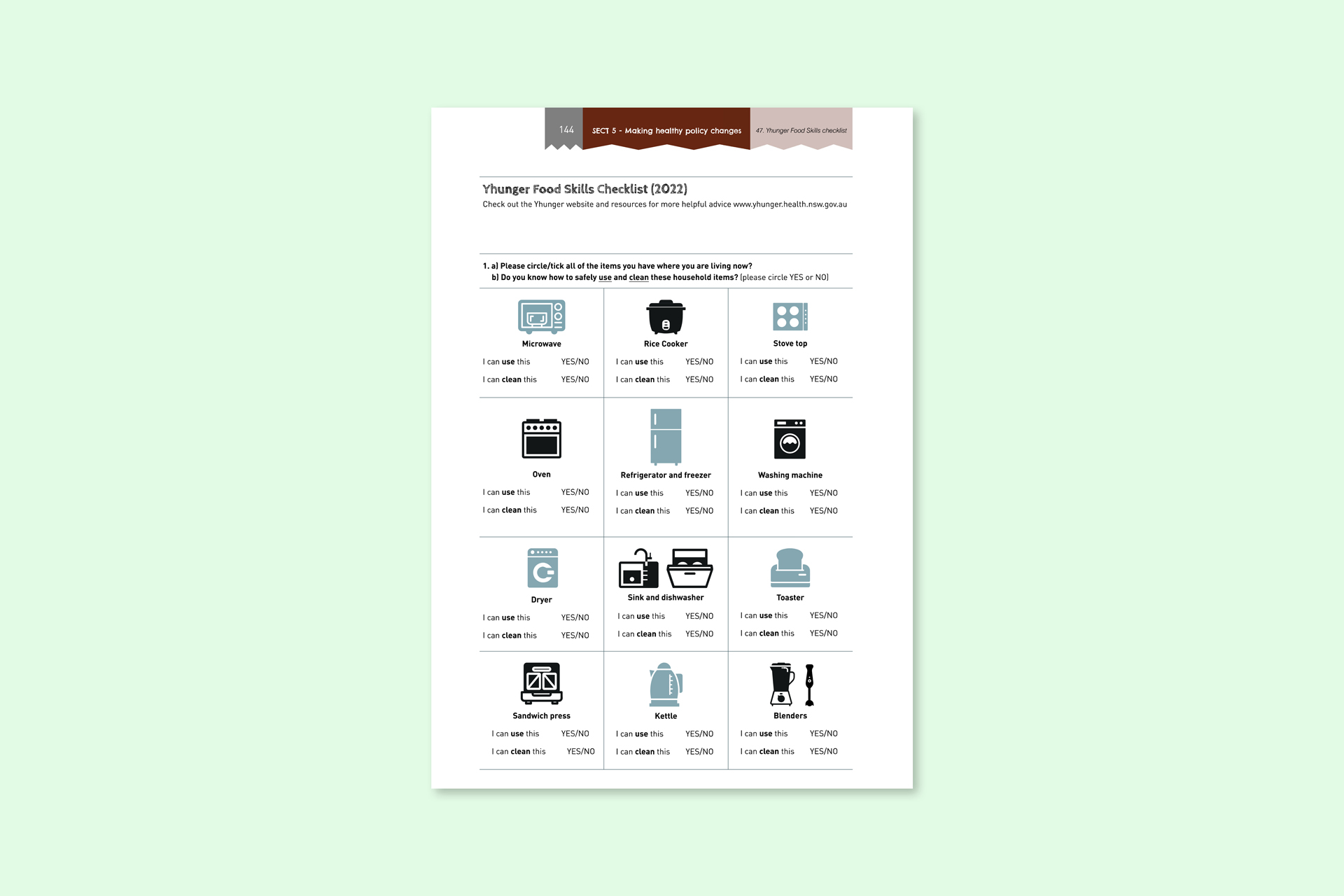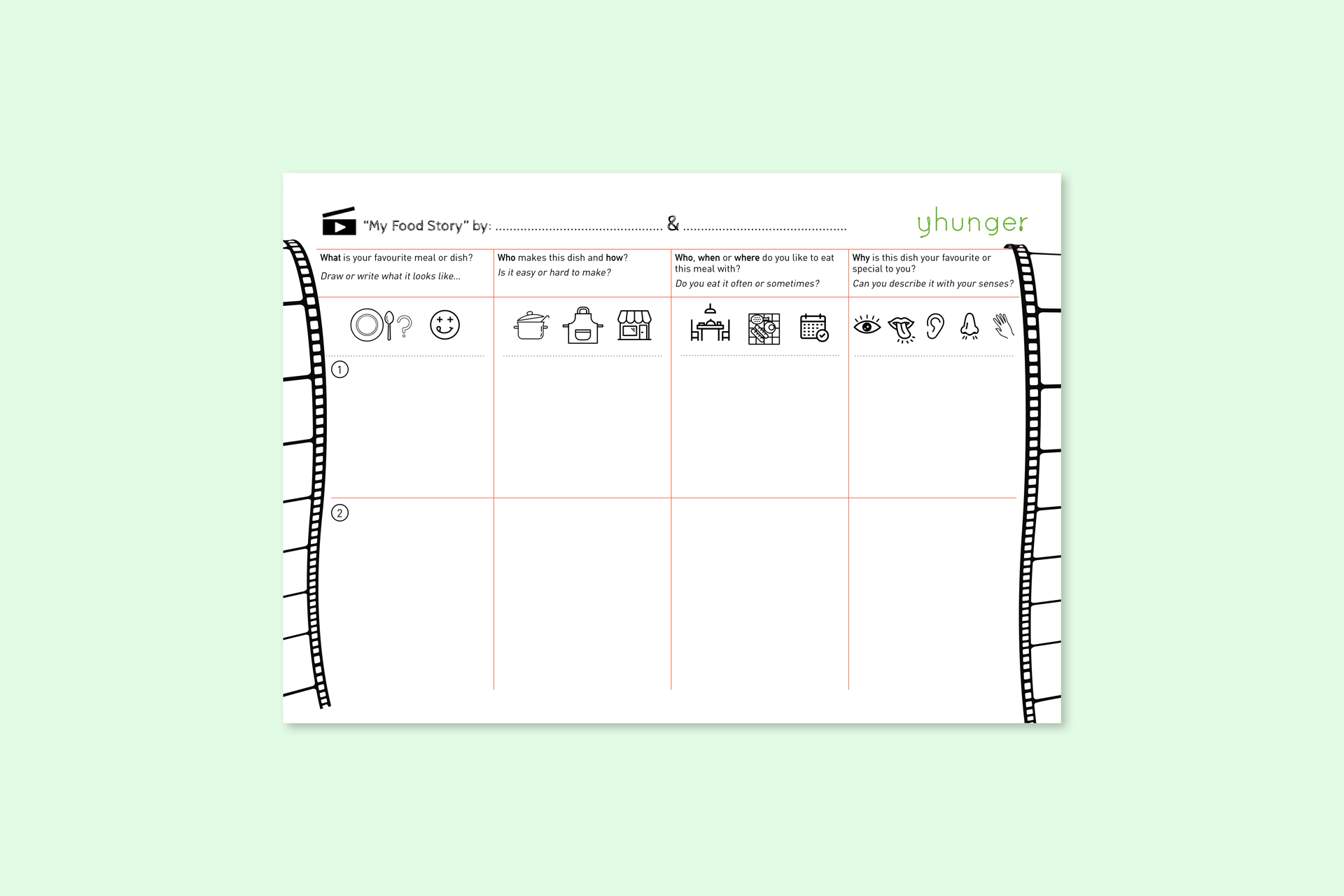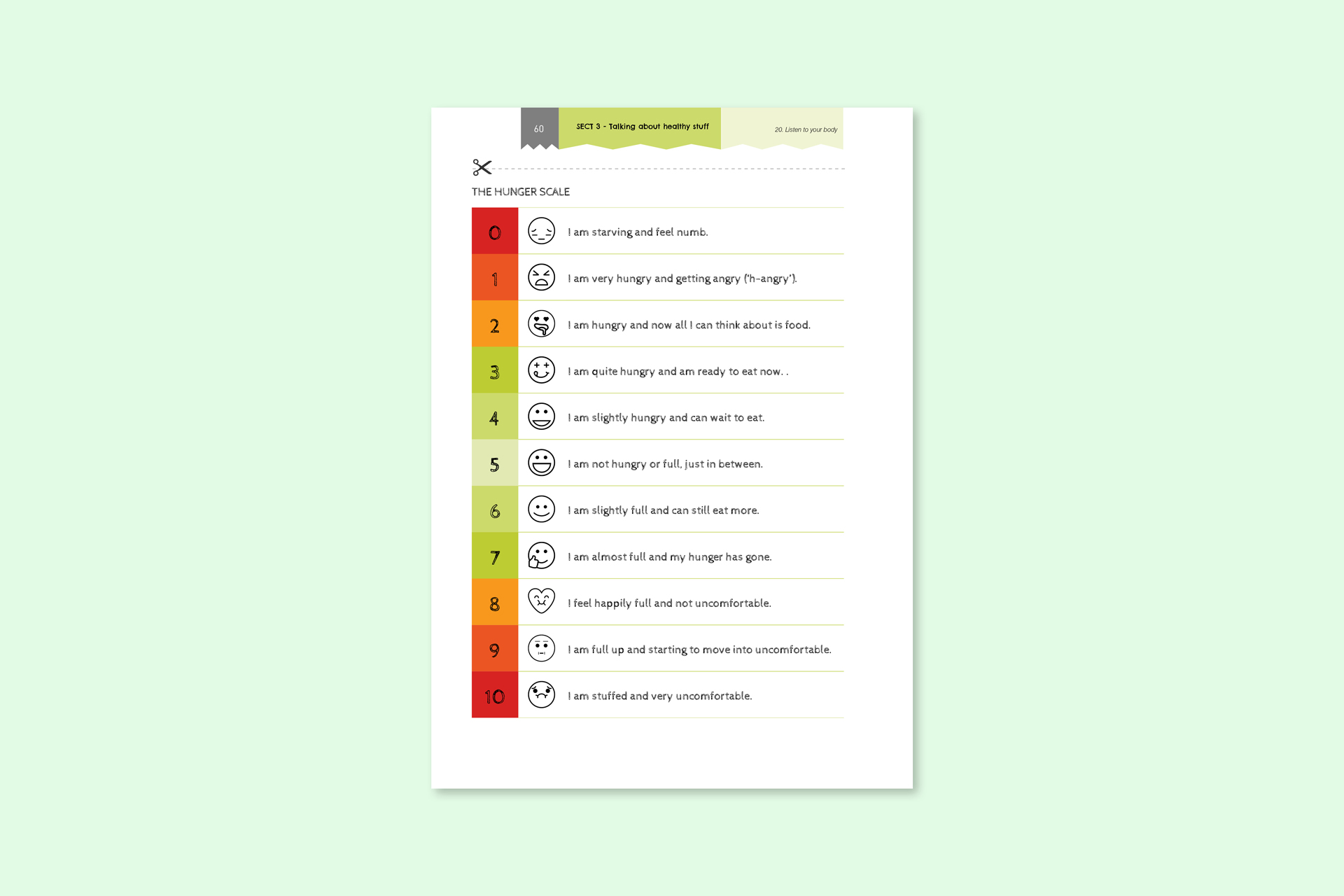
Games, activities and resources
Food skills checklist

Our food skills checklist is a handy tool for case management and/or program planning with young people. It is particularly helpful for young people who are getting ready to live more independently.
Always keep in mind the food skills discussed are life skills that we practice and learn over time, so it is ok if some aspects are unfamiliar or new to you.
Youth settlement services and young people from refugee backgrounds co-designed this tool with us as part of the Yhunger Refugee and Asylum-Seeking Youth (RASY) project. The NSW Refugee Health Service has translated the checklist in five community languages. The checklist is useful in the MYAN National Youth Settlement Framework (personal wellbeing). For health and youth services, this checklist is useful in intake procedures or a HEEADSSS assessment, during case management, or as part of evaluating a community food program.
Why put this activity on the table?
This activity is for young people and their support workers to:
- Identify areas of food skills and health literacy that may need attention or prioritising
- Recognise change and improvement over time
- Start a reflective dialogue about living skills development
- Assess young people’s readiness for independent living
- Build the capacity of a young person’s personal wellbeing
- Elucidate a young person’s issues around food security in resettlement
| Serves | Individually, together with a worker, with housemates or others in small groups. |
|---|---|
| Preparation time | Minimal – just have a copy of the template handy. Remember you don’t need to know all the answers. Learn by discovering and doing together. |
| Cooking time | Allow 10-30 minutes, with discussion. You can also break up the sections and do them at separate times to make it easier for young people to complete the checklist. |
| Ingredients and equipment |
You will need a printed or online copy of the Yhunger food skills checklist and a way to record and revisit the answers later.
Download the food skills checklist in language: |
Steps to do this activity
- Firstly, reassure the young person that these are skills that they can spend a lifetime learning – they don’t have to learn them all at once or know it all now
- Work through each section with the young person/people. You don’t have to do the checklist in chronological order. Pick the section most relevant for the present situation
- If doing individually, you could fill it out with them as a conversation or they can complete it on their own. Use your professional judgment or ask them what they prefer
- If doing as a group, they can fill out a section or whole checklist individually or by interviewing each other in pairs
- Together, decide on what areas to focus their living skills learning on and how you can support their skill development in the service you provide or with others
- In most cases, you will be able to share your experiences, supplement your knowledge with the Yhunger resources or search for sensible ‘life hacks.’ Role model these in your youth practice and relationship to food
- Revisit the checklist over time to see how their food skills and health literacy has improved and provide positive re-enforcement and praise
My food story

Our my food story activity is designed to get participants talking about their food preferences and the memories and meanings they associate with a favourite dish or meal. A food story can be an experience that brings up memories of a time, place, people, tastes, smells, sounds and sensations.
In this activity, the storyteller can choose how they want to share a part of their culture, how they identify, meaningful values, special people, their relationship to food, and how they like to celebrate and connect. A simple food story may contain meanings of home and reflections on the refugee experience and resettlement process. This may include family separation and trauma informed practices are advised. Please try to create a non-judgemental and respectful experience for everyone.
Why put this activity on the table?
This activity is for young people and support workers to:
- Develop respect for others’ food preferences
- Discuss how they feel about eating specific foods
- Develop respect for cultural differences and divergent views
| Serves | Individually or in pairs in group programs. Also suitable for case management. |
|---|---|
| Preparation time | Minimal – just have a copy of the template handy. |
| Cooking time | Allow 10-20 minutes, depending on if they are completing individually or in pairs. |
| Ingredients and equipment | You will need printed or online copies of the Yhunger my food story activity template and drawing/writing equipment or a device to record the story on, for example a mobile phone. Download activity |
Steps to do this activity
- Use a space where young people can easily write and draw. Have participants take turns to interview each other in pairs or individually if they prefer. Allow time for participants to respond to each column. The first story from one person is recorded on the top half, the second story from the other person can be recorded on bottom half of the template (forming a basic storyboard)
- Have participants take turns to share each other’s food story with the rest of the group. Acknowledge we all have different food preferences and lived experiences. A young person may not have the language or literacy skills to express their story. Allow extra time if language support or a translator is needed to help with participation
- Be aware that this may trigger an emotional or physical response for some participants. Food stories can invoke a powerful sensory memory and remind us of people and places that are no longer present or lost. Create a safe space and time to rest, self-regulate or debrief during or after the activity
- Resources permitting, try out digital storytelling like we did with our beautiful Yhunger food stories. Three of our food stories were co-created with the winners of the food storytelling competition with CuriousWorks, a Western Sydney community arts organisation. The food stories were premiered at a youth event for Refugee Week at PYT Fairfield in 2022, as part of the Yhunger Refugee and Asylum-Seeking Youth (RASY) project.
Hunger scale

Our hunger scale activity is a way of exploring cues including satiety, hunger, mood and daily habits that affect eating patterns. It can be used to help young people struggling with disordered eating. The scale can introduce people to the concept of intuitive eating, that is, listening to what your body is telling you through fullness and hunger cues, eating mindfully, practicing food neutrality (the idea that food is just food), that your body enjoys movement and eating is contextual and social.
However, please be aware that some aspects of intuitive eating and the hunger scale may feel inaccessible for neurodiverse young people, unless you explore and adapt to more individualised ways and suggestions. Learn more about how to do this at the Embrace Hub.
Why put this activity on the table?
This activity is for young people and support workers to:
- Identify cues, including hunger, mood and other issues, which affect people's eating patterns
- Explore the links between food and emotions and their effects on wellbeing
- Be more self-aware of different ways our bodies and minds express hunger and fullness, and social, environmental and cultural situations that can influence this
- Explore the personal impact and common experience of food insecurity as a group
- Participate in and feel supported in the group
| Serves | Groups of 3-15 people or adapt for individuals in case work. |
|---|---|
| Preparation time | Allow 5-10 minutes to copy, cut and set up the hunger scale in the room. |
| Cooking time | Allow 15 minutes for the group discussion. |
| Ingredients and equipment |
Select a room with space for participants to move around. You will need a print out of the Yhunger hunger scale, with the labels (0-10 and their descriptions) cut into separate pieces. Increase the print size of the hunger scale between 170-200% or print on A3 paper. If you don’t have a printer, draw the emojis and write the descriptions on 10 pieces of paper or blank cards. Optional: Box/glass jar/cardboard or butcher paper to collect ideas or make a collage (for individuals or a group). |
Steps to do this activity
- Set up the hunger scale with labels spaced evenly out on the floor from 0 to 10 (‘starving’ to ‘stuffed’)
- Ask everyone to do a quick body scan, then go and stand on the scale that aligns with how they feel right now
- Enquire at different points of the scale:
| What’s happening in our bodies to match this description? | Hunger cues include headaches, difficulty concentrating and listening, feeling restless and agitated, having stomach pains or growling sounds, bad breath, having more saliva in their mouth, or food dominated thoughts and dreams. |
| Can they share their ideas for why they are standing at that description today? |
Validate that there are lots of reasons why someone’s hunger cues might be impacted. For example:
|
| What are some other reasons that trigger eating? |
They could be:
|
| How can you stop eating too much when you have reached fullness? |
|
Optional: Create a box/jar/collage with suggestions of things you or a friend could do instead of eating if you aren’t hungry. Examples may include going for a walk, painting/drawing or listening to music. Keep the jar full of handy ideas for when you cannot think of what to do. Only share strategies with the group if participants are comfortable to do so.
Additional notes for facilitators
- Variation for individual case work: start at step 2 or 3. Have a copy of the hunger scale activity on hand to discuss. Keeping a food and mood diary for a short period of time might help identify internal and external cues for eating
- People who can eat regularly throughout the day generally maintain a healthy body weight throughout their life. Even so, intuitive eating is about making peace with your food and respecting what your body needs to thrive, so it’s more holistic than dieting goals and defining your self-worth by the number on the scales or health status by BMI
- Food insecurity is defined as “a limited or uncertain availability of nutritionally adequate and safe food or limited or uncertain ability to acquire foods in socially acceptable ways” (Food and Agriculture Organisation, 1996). Acknowledge that people who experience food insecurity can become preoccupied with food and are more likely to binge when food is available
- Our Yhunger research found food insecurity rates were very high among homeless young people, even when living in supported accommodation. The main issue affecting food insecurity was poverty (Crawford et al, 2014).
- Let’s try to meet young people where they are at in their food needs. Are their basic needs being met? Can we establish a sense of safety and belonging together in the kitchen? Are they feeling more confident now to try new foods and more nutritious options? We find reflecting on Satter’s Hierarchy of Food Needs is very helpful for facilitating this activity and other Yhunger activities
- If binge eating is a regular occurrence (For example, weekly), check out these free online resources together: Break Binge Eating: Evidence-Based Eating Disorder Advice & Support, Urge surfing and the Inside Out website
Helpful resources
| Nutrition on a budget – Central Coast Local Health District | Visual resources to help prepare easy, low-cost and nourishing meals and snacks. |
|---|---|
| Healthy recipes – Healthy Eating Active Living | For more fast, simple, budget friendly meal and snack ideas. |
| Food calculator: what to eat and how much | The food calculator can help you work out what you (and your family) need to eat healthily. Enjoying a variety of food from the five food groups helps support overall health. |
| Do you know what a standard drink looks like? | Learn how many standard drinks are in common glasses. |
| Get Healthy Service | Offers free phone and online health coaching to help you make lifestyle changes to improve your health. Delivered by NSW Health, the service is available to people over 16 years of age living in NSW. |